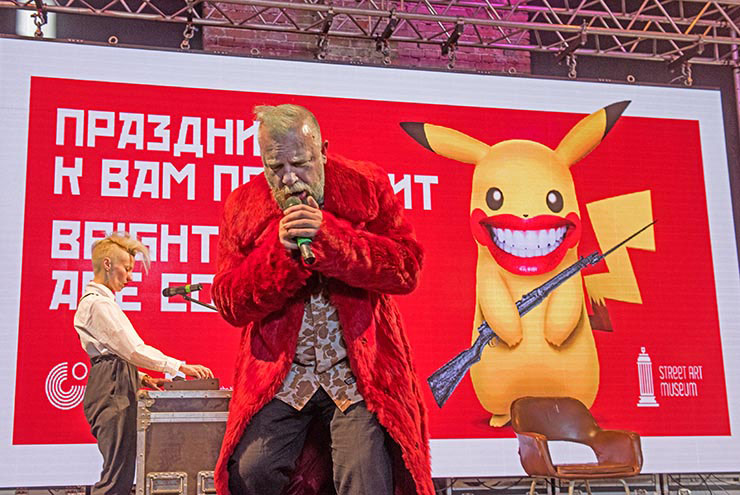A New Exhibition Marks the 1917 Revolution in St. Petersburg at the Street Art Museum
This spring, a hundred years since the Russian Revolution, a new Street Art inspired exhibition in St. Petersburg may reflect the ambivalence that competing storylines produce in the re-telling of history. A hundred years since the workers movement displaced the Czar and his family following three hundred years of power, the streets don’t look like they will return to the Bloody Sunday of hundreds of workers lying on the pavement, but a certain unruly violence can be sensed in the performances and artworks nonetheless.
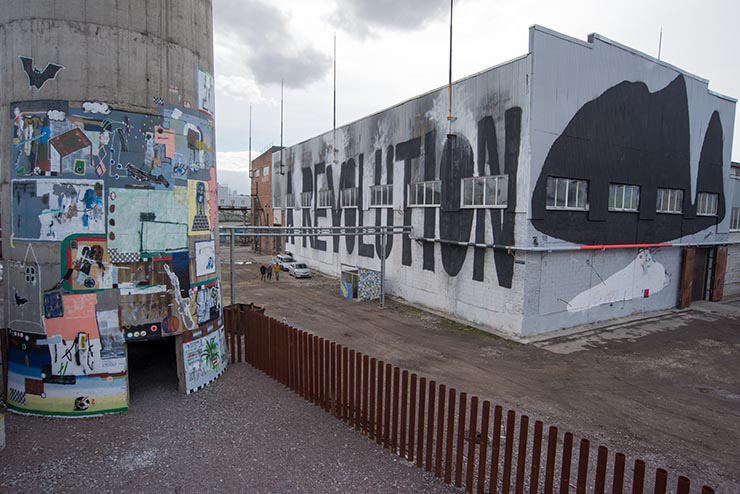
Street Art Museum. Saint Petersburg, Russia. May 2017. (photo © Martha Cooper)
“Brighter Days Are Coming”, co-curated by Andrey Zaitsev, the director of Street Art Museum and Yasha Young, director of the Urban Nation Museum for Urban Contemporary Art in Berlin, brings the voices of 60 current artists with roots in the Street Art/ graffiti practice to discuss that specific revolution or the theme of revolution itself. Largely from Russia and using everything from aerosol to concrete to bricks to bones to smoke, it would appear that the effects of 1917 are even now difficult to resolve.
The Street Art scene is familiar with the schizophrenia of identity and the loosely tossed labels that never exactly fit. Multiple participants and categories of art-in-the-street now apply – perhaps reflective of the multiple individual stations one can occupy in society: citizen/ loyalist/ worker/ owner/ globalist/ revolutionary/ consumer. Awash in the borderless Internet of everything and nothing, it is often the youngest adults for whom Street Art appeals and has currency, an imperfect authenticity you can engage with. Ironically, there may be a way to accommodate these ubiquitous monuments of Lenin and other static heroes in your periphery as you walk by them playing with Pokémon on your digital device. One way is to make them your own.
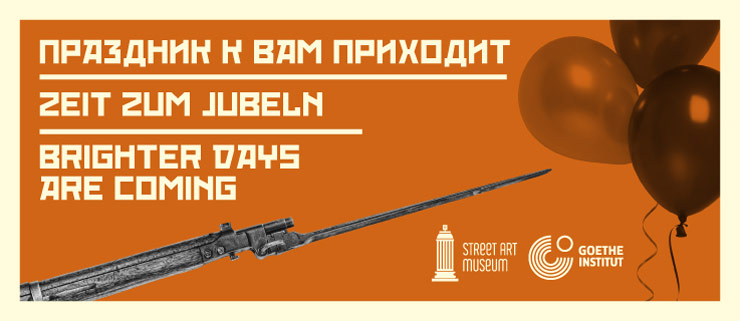
Clicking “Like” Won’t Do It
There is a struggle today to discern the cultural weight and meaning of visual culture because hierarchies have been flattened and distance is seemingly elastic in our digital experience. Iconic Lenin may mistakenly be reduced to icon Lenin, a simplified button on one’s phone. The digital space can create a sense of intimacy with strangers and yet an odd distance when considering actual lives of peasants, or the fight of the workers, or the struggle of artists for that matter.
One sure way to appreciate art is to see it in person, to contemplate while gazing on the expanse of an enormous mural or trudging across the grounds of this plastics factory/ Street Art Museum on the outskirts the former Petrograd – one that was begun by twenty-somethings in love with global Street Art and is heavily populated with them.
Indeed a low-budget looking satirical promotional video for the exhibition posted on the Street Art Museum Instagram page appears as a mocking half-hearted celebration by costumed Russian Millenials and Gen Z’s dancing around a smiley icon cake whose dynamite candle suddenly explodes in a bit of stock video of a fiery Armageddon.
What is the future or past we’re celebrating? Does anyone know? Thanks to the explosion the video feels humorously heavy in the foreboding sarcasm department. Maybe it is just an insider reference to a favorite movie scene or video game. There ARE, after all, three curious Pokémon characters at the kitchen table. The official poster features the cheerful sunshine-yellow Pokémon with lipstick and a full-mouthed smile. Somehow it has more credibility than any human figure, smiling and terrifically positive that the future is bright.
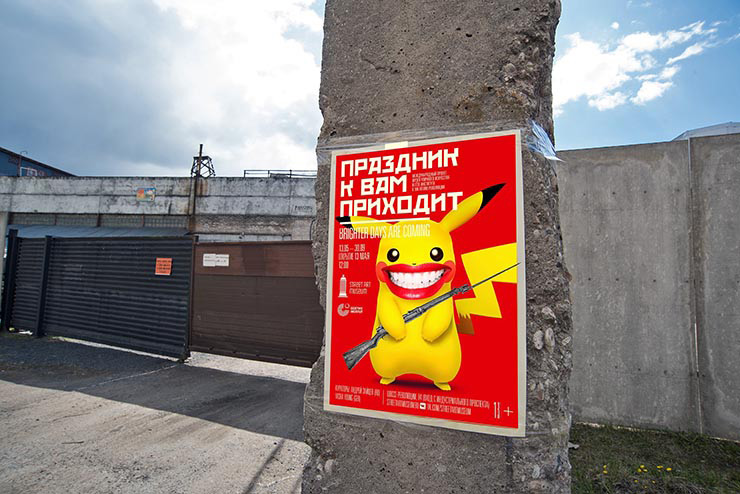
Poster for Brighter Days Are Coming. Street Art Museum. Saint Petersburg, Russia. May 2017. (photo © Martha Cooper)
Walking Inside and Out
The fourth such large exhibition in this suburban factory campus and its open outside space since the museum received official accreditation in 2012, this season at The Street Art Museum features 60 or so artists from 12 countries who look to the events 1917 for inspiration. As organizers note on the museum website, the topic is being addressed with retrospective shows this year by great museums worldwide including The MOMA in New York, Tate Modern in London, the Hermitage, the Russian Museum, and the Tretyakov Gallery in Russia.
“The main object is the heritage of the Russian avant-garde, whose world-spanning and messianic spirit had a serious effect on the development of contemporary art,” explains the site. For practitioners and fans of the graffiti and Street Art scenes that have evolved in cities globally during the last 50 years, one revolution or another is never far from their mind at all. At the epicenter of history here in Shosse Revolutsii, the Street Art Museum is an appropriate place to at least contemplate the subject.
Large scale installations on walls throughout the compound are complemented by sculptures in open spaces; some of them interactive, others static, still others are reproductions of historic and recognizable figures. Most commanding would be the Lenin. Most remarkable would be the reproduction of The Hermitage.
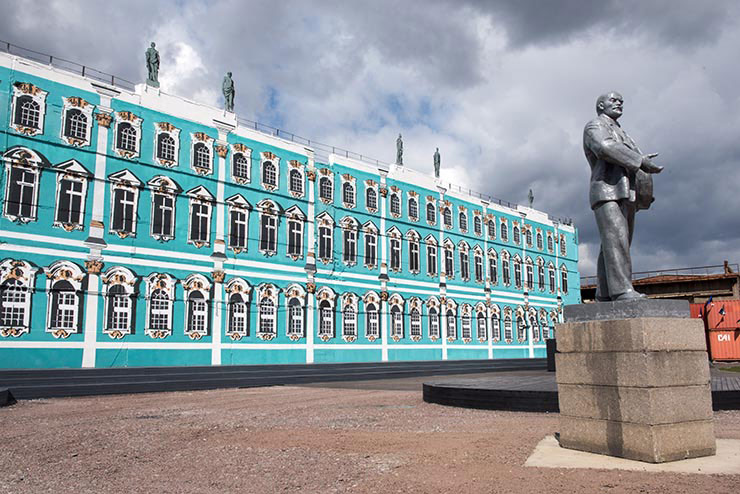
The exterior walls of the compound were painted to mimic the Hermitage Museum. Street Art Museum. Saint Petersburg, Russia. May 2017. (photo © Martha Cooper)
The recreating of The Winter Palace façade is a guilty delight, one of the 6 buildings of The actual Hermitage that holds the world’s largest collection of paintings only kilometers from here. A world icon of the revolution since being stormed in the fall of 1917, the massive aquatic (or French) blue facsimile of the façade in this museum courtyard provides a haunted, riveting, and admittedly comedic context for everything that passes by it, behind it, before it.
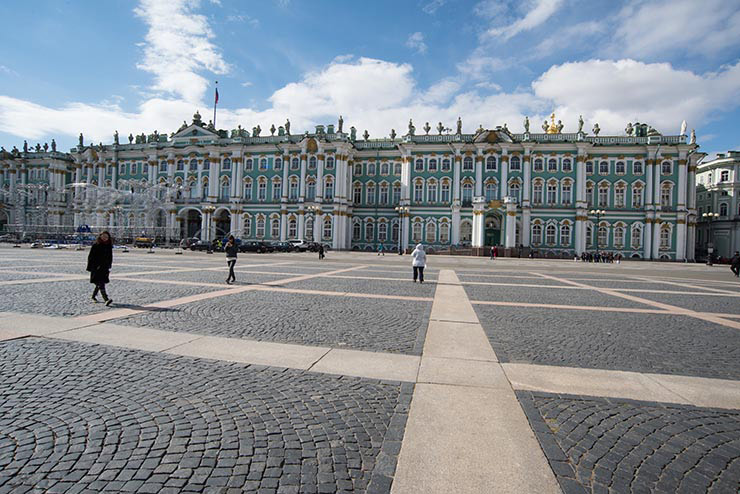
Hermitage. The real one. Saint Petersburg, Russia. May 2017. (photo © Martha Cooper)
Individual Interpretations of “Revolution”
Elsewhere Lisbon based Street Artist Bordalo II has brought his practice of creating an endangered animal with local garbage for his installation of the famous Russian Snow Leopard – an animal now critically endangered, with its numbers estimated by some as 100 or less. One may wonder, certainly these artists do, what animal species will still be here in 2117.
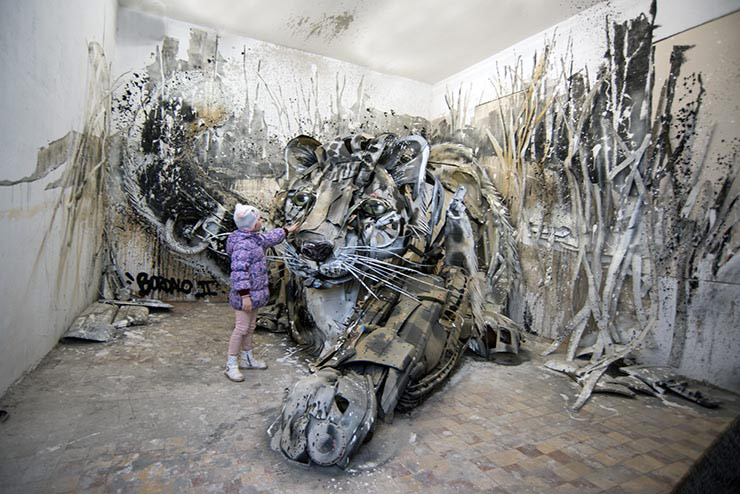
Bordalo II (Portugal). Snow Leopard. Street Art Museum. Saint Petersburg, Russia. May 2017. (photo © Martha Cooper)
Russian artist Dima Rebus watercolor painted one of his character’s faces on the bottoms of 340 oil barrels by hand as a nod to the mobs of people who gathered together to form the the uprisings of the revolution. He says he has plans to disperse the mob wall, to vanish it at the end of the exhibition, painting each person out one by one with spray paint. Entitled “Life Goes On” the artist says, “Revolutions happen and pass, but life goes on.”
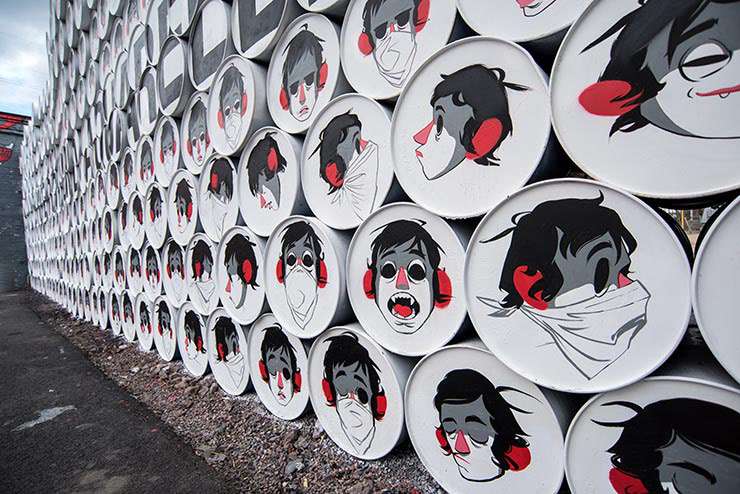
Dima Rebus. (Russia) “Life Goes On” Street Art Museum. Saint Petersburg, Russia. May 2017. (photo © Martha Cooper)
The Italian illustration-style Street Artist name Millo painted one of his imaginary highrise milieus where a giant child is at play in the center of an urban setting. The revolution here is the represented by the ripples of waves passing literally through the character, he says. On social media he describes it this way, “Each planet follows its orbit and all of them are the personification of the revolutions lived by the main figure. The message I want give is to find your personal revolution. When something is getting over is the exact moment to find the strength to revolution”.
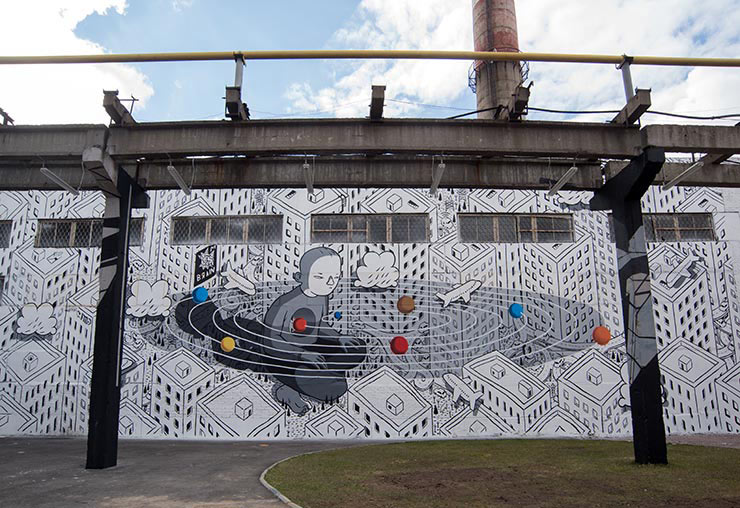
Millo. (Italy) “Revolution”. Street Art Museum. Saint Petersburg, Russia. May 2017. (photo © Martha Cooper)
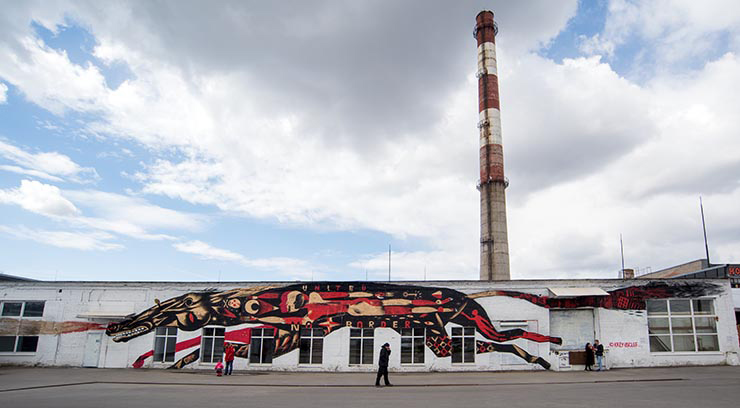
Kazy Usclef. (France) “Makazyhnovchtchina”. Street Art Museum. Saint Petersburg, Russia. May 2017. (photo © Martha Cooper)
French Street Artist Kazy Usclef (above and below) normally draws influences from Futurism and Suprematism so his connection to the Russian avant-garde is a short distance. He also isn’t afraid to touch upon current political sore spots.
In “Rebel Sex Love Resistance,” the two entwined figures are female and one is wearing a balaclava, features that together are perhaps subtle references to the activist art music group named Pussy Riot, famously contentious and Anti-Putin.
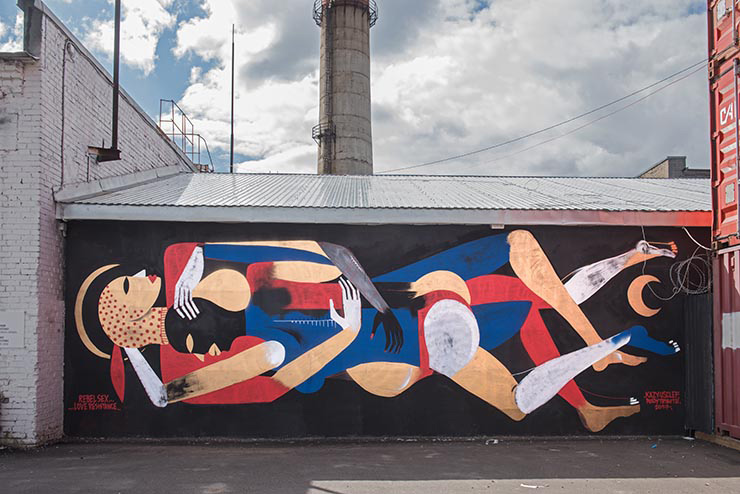
Kazy Usclef. (France) “Rebel Sex Love Resistance”. Street Art Museum. Saint Petersburg, Russia. May 2017. (photo © Martha Cooper)
Performance, Panels, Debates
During its opening days the exhibition featured ongoing performances by contemporary artists and independent theater troupes, turning the courtyard into a stage and the “Hermitage” into a set.
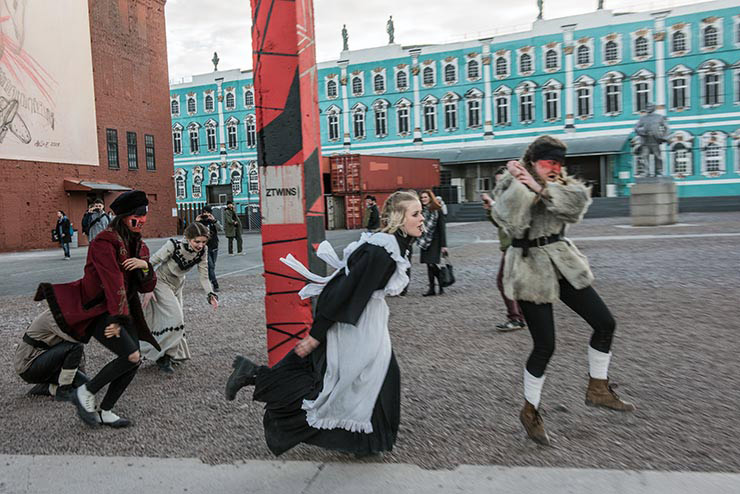
Maksim Svitshyov. Media-art and sound-art project. Street Art Museum. Saint Petersburg, Russia. May 2017. (photo © Martha Cooper)
Lead by curator and theater director Danil Vache, costumed performers appear to take inspiration from specific historical events and themes of radical change, societal rupture, militarism, and the uprising of poor and working class to claim power. Inside and onstage, live performances of poetry, speeches, and music were featured throughout the week.
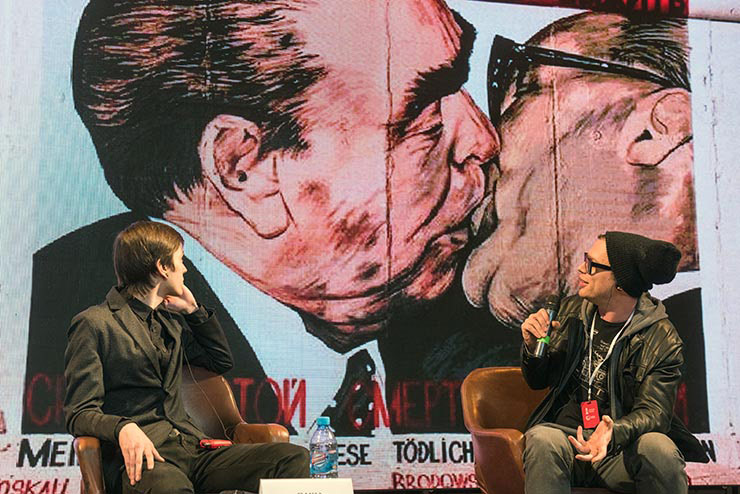
Artist Pasha Kas and the UN’s Denis Leo Hegic discussing My God, Help Me to Survive This Deadly Love sometimes referred to as the Fraternal Kiss (German: Bruderkuss), a graffiti painting on the Berlin Wall by Dmitri Vrubel, 1990. The painting depicts Leonid Brezhnev and Erich Honecker. Street Art Museum. Saint Petersburg, Russia. May 2017. (photo © Martha Cooper)
Additionally there were a few panel discussions and forums like “Simulacrums of Revolution,” where moderating curator/ theatrical producer Mihail Oger spoke in conversation before an audience with guests like American graffiti/Street Art photographer Martha Cooper, Ukrainian artist Pasha Kas; Russian graffiti writer and contemporary artist Maxim Ima, graffiti/public artist Anton Polsky (known as Make), and Urban Nation (UN) Cultural Manager Denis Leo Hegic. Hegic, who spoke before images of the Berlin Wall during his presentation, tells us about his and the UN’s involvement with the exhibition.
Maksim Svitshyov. Media-art and sound-art project. Street Art Museum. Saint Petersburg, Russia. May 2017. (photo © Martha Cooper)
BSA: The title of the exhibition is sort of a satiric, sunny reference to a happy future – “Brighter Days Are Coming”, yet it is cast directly under the shadow of the hardship and conflicted relationship Russian’s and all of us have with the past. How did you see the exhibition responding to this dichotomy?
Denis Leo Hegic: The title of the forum “Simulacrums of Revolution” is actually a good supplement to the title of the exhibition itself, since the idea was not to define revolution or to claim revolutionary DNA, but to reflect on what is the “Representation” of revolution on various levels and in our own understanding, in historical, scientific definitions and in the artistic representation.
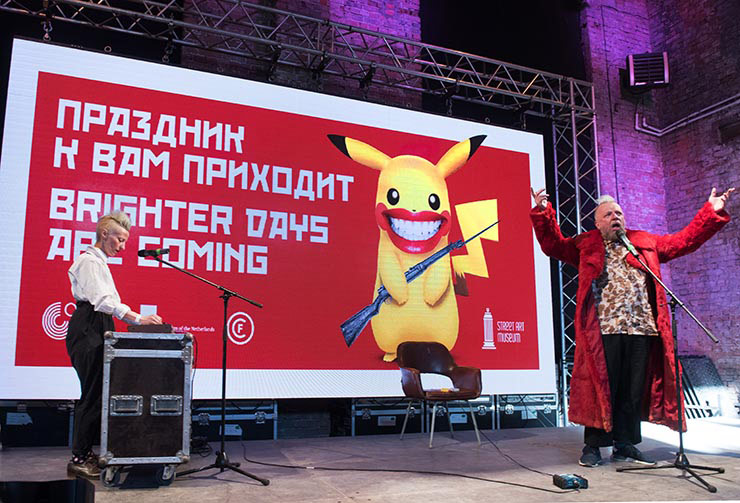
Maksim Svitshyov. Media-art and sound-art project. Street Art Museum. Saint Petersburg, Russia. May 2017. (photo © Martha Cooper)
Hegic points to the age old practice by humans of the falsification of historical events to form a narrative. He also points to “fake winter palace or the fake museum” and compares it to the famous painting “The Storm on the Winter Palais” by Pawel Petrowitsch Sokolow-Skalja as examples of re-writing history. You can almost anticipate that Hegic will transition readily into the topic of “fake news” or “propaganda,” but he takes another damning route instead.
“We can draw parallels to the fakeness of our own representation today – with our own “curated” Instagram accounts, or the millions of selfies we make from flattering angles – this seems to be a considerable part of our daily thought and activities. This is where I see the direct link to the representational powers of every revolution in our own present time.”
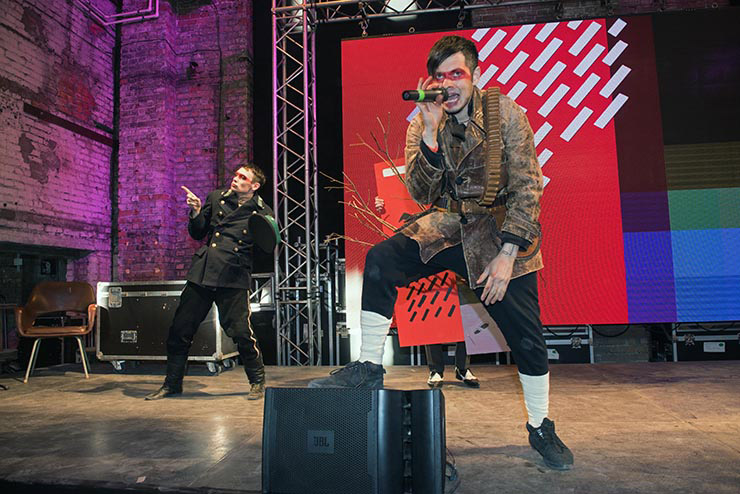
Maksim Svitshyov. Media-art and sound-art project. Street Art Museum. Saint Petersburg, Russia. May 2017. (photo © Martha Cooper)
He also disagrees with how we characterized the title of the exhibition, “Brighter Days Are Coming.”
“The title should not necessarily be understood as a satiric one,” he explains. “Brighter days are always about to come. The light will inevitably win over the darkness and human optimism will remain a motor that keeps our evolution process in motion. Ironically, our evolution itself might bring our extinction too – but under the assertion ‘Brighter Days Are Coming’ we do continue to live and to hope.”

Alexander Berzing. (Russia) “Contact”. Street Art Museum. Saint Petersburg, Russia. May 2017. (photo © Martha Cooper)
Pulling Back the Curtain
The museum itself, stationed on the campus of an operating plastics factory and under the directorship of the son of the owner, highlights some of the conundrums of featuring autonomous global public art movements in a time and place where official state messages speak more to loyalty than revolution. For many critics, Street Art belongs in the street, so the very existence of this institution is a non-starter.
Finally it is notable that St. Petersburg itself has very little of what you may call an “organic” Street Art scene – and one does not see Fascist or AntiFa post-Soviet graffiti furiously scrawled here. This appears to be comfortable protected space for debate about theory and history not easily identified by a graffitied or muralled exterior.
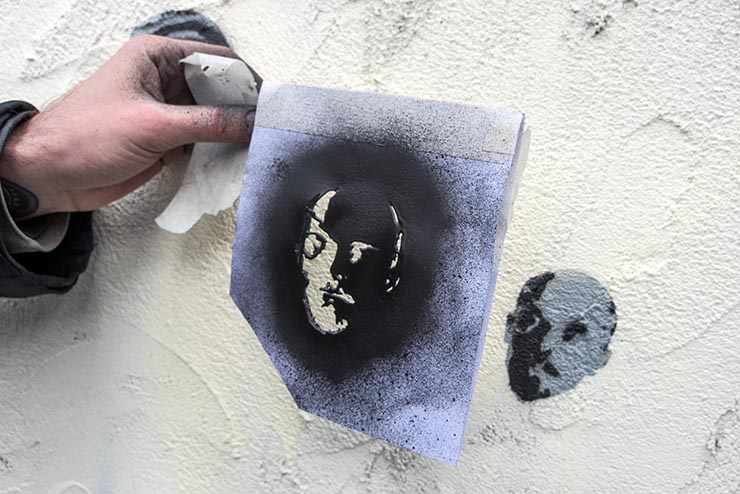
Aleksandr Gushing. (Russia) “Lenin – Grad”. Street Art Museum. Saint Petersburg, Russia. May 2017. (photo © Martha Cooper)
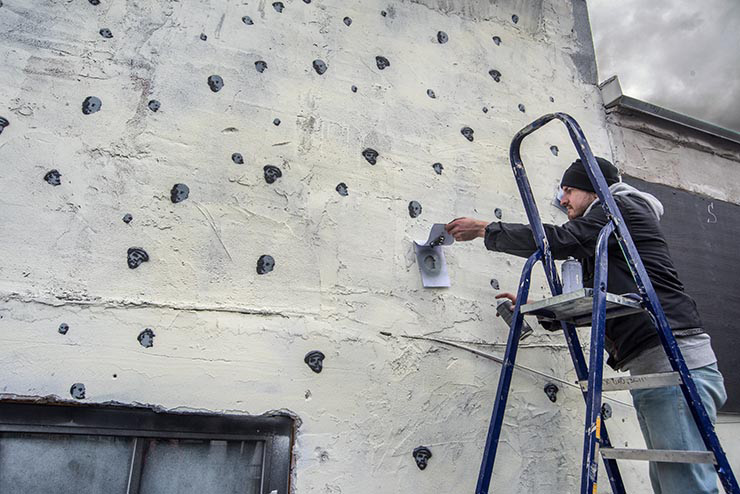
Aleksandr Gushing. (Russia) “Lenin – Grad”. Street Art Museum. Saint Petersburg, Russia. May 2017. (photo © Martha Cooper)
But these are only a few of the multiple ironies at play in the organized chaos of today, where the German Goethe Institute and Berlin’s Urban Nation Museum of Urban Contemporary Art are partnering with the St Petersburg Street Art Museum to launch a show commemorating the 100th anniversary of the Russian Revolution. For those who do not know at that time Russia and Germany were engaged together with Austria in a brutal and bloody war that killed three million people.
For the sixty or so artists and performers participating inside these factory walls you may also wonder how or if their work has been affected by the work of this Revolutionary era’s giants in literature, ballet, painting, music and movies — people like Serge Diaghilev, Igor Stravinsky, Sergei Eisenstein, Vladimir Mayakovsky and Kazimir Malevich. Each of these names became as closely identified with their disciplines as the politically, socially, anthropologically tumultuous eras they worked within.
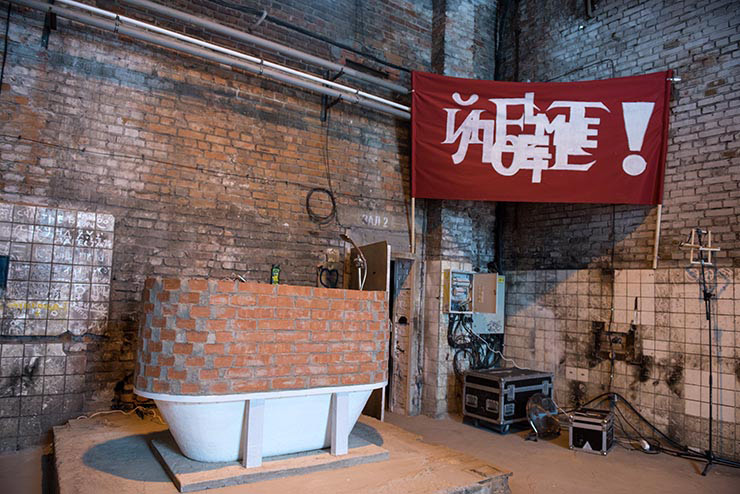
Icy & Sot. (Iran/USA). “Lack Of Privacy” Street Art Museum. Saint Petersburg, Russia. May 2017. (photo © Martha Cooper)
As in every era, today technological revolutions are affecting all people regardless of nationality or national politics.
The Iranian Street Art duo who currently live in Brooklyn, Icy & Sot, steer clear of the politics of nations in their installation by building a wall – itself overlaid with political overtones – but here it is intended as a metaphor for protecting privacy. By bricking up the periphery of a bathtub, the brothers contemplate “No Privacy”, an occurrence enabled by our complicity (and obliviousness) to being tracked and followed by strangers via our smart phones.
NO PRIVACY from ICY And SOT on Vimeo.
“The bathtub and shower are everyone’s private place,” they tell us. “In this installation, even though we built a wall around the tub there is still no privacy because there is a smart phone playing music nearby, enabling some entity to always watch or listen to you.”
A Final Word
By focusing this large exhibition at its original epicenter organizers are bound to strike nerves and inflame passions and, although Russians don’t appear to be exactly celebrating the centennial, the opinions about who deserves blame and credit for the events that unfolded are all over the map. Which is why, perhaps, curators looked far for new takes on the topic.
“First and foremost this exhibition was meant as a representation of a broad international scene,” says Denis Leo Hegic as he talks again about the perspectives artists here bring to the topic of revolution. “The artists curated by the UN were all coming from different countries, bringing different ideas of portrayal and embodiment of revolutionary experience. The starting point of this revolution in 1917 did not stop at national boarders and claimed to be an international or even global movement.”
“Similar this is probably the most direct, democratic and largest global art movement today so the choice to bring international guests, with their own historic and different national backgrounds and their individual talents and approaches to creation – these were the most valuable contributions to the exhibition and the audience.”
Our sincerest thanks to Martha Cooper for sharing these photographs with BSA readers! We really appreciate all that she does and who she is to so many.
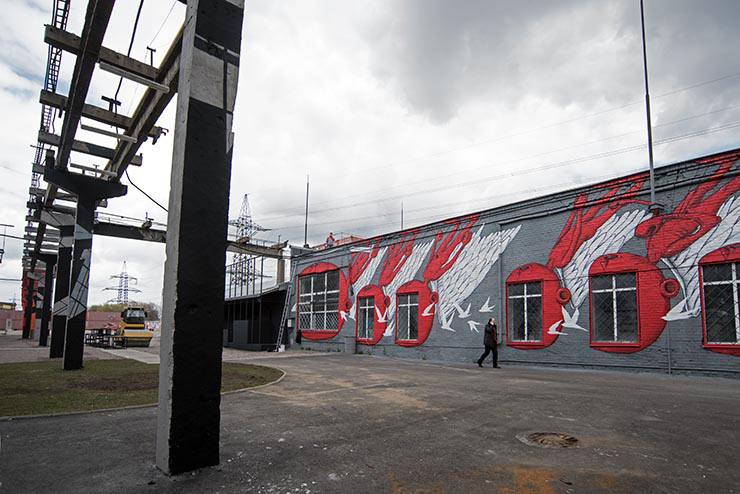
Alexander Blot. (Russia) “Upheaval”. Street Art Museum. Saint Petersburg, Russia. May 2017. (photo © Martha Cooper)

Konstantin Novikov. (Russia) “Where are my Seventeen”. The artist contrasts the time intensive and walls built for The Hermitage versus modern mass production creation of walls. 17 marks the year of the revolution as well as the number of years Vladimer Putin has been at the top. Street Art Museum. Saint Petersburg, Russia. May 2017. (photo © Martha Cooper)
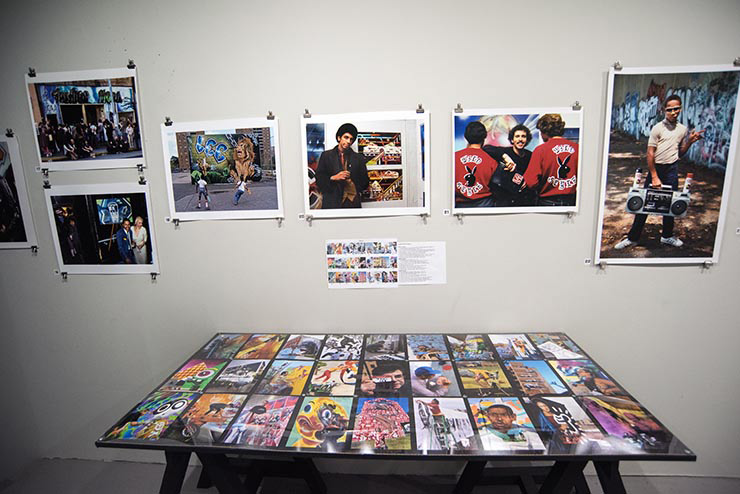
An exhibit of photographs by Martha Cooper. (USA). Street Art Museum. Saint Petersburg, Russia. May 2017. (photo © Martha Cooper)
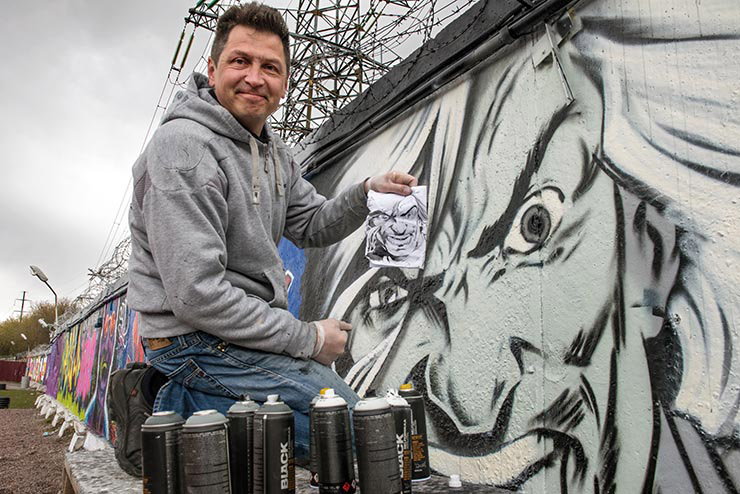
Max Navigator. (Russia). Street Art Museum. Saint Petersburg, Russia. May 2017. (photo © Martha Cooper)
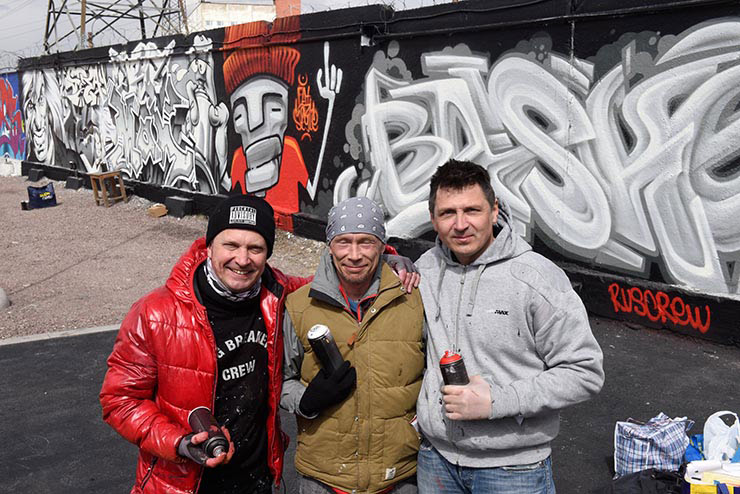
From left to right: Vadim Krys (Lithuania), Basket (Russia) and Max Navigator (Russia). First Wave of Graffiti in USSR at the Street Art Museum. Saint Petersburg, Russia. May 2017. (photo © Martha Cooper)
Krys has been doing graffiti since 1985 and is one of the pioneers of graffiti in the Soviet Union. He was inspired when he first saw the American documentary “Hip Hop and Its History” when he was 14 years old. Basket and Max are also pioneers of graffiti in the USSR.
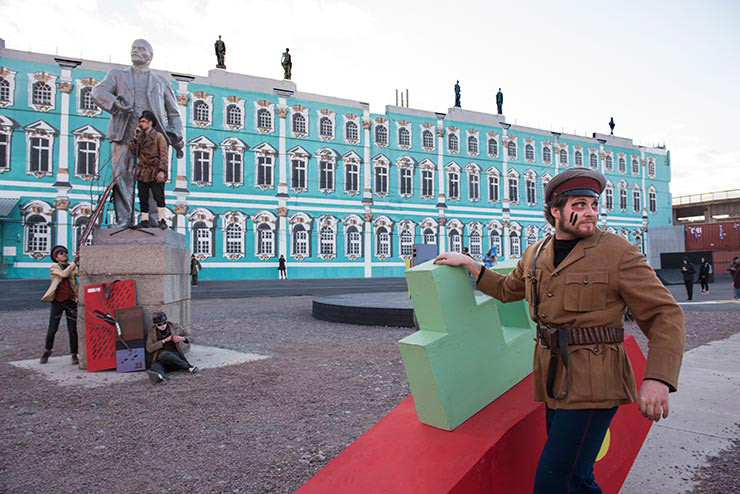
Maksim Svitshyov. Media- art and sound-art project. Street Art Museum. Saint Petersburg, Russia. May 2017. (photo © Martha Cooper)
The final attack of the Red Guard to the Winter Palace from the movie October by Sergey Ezeinstein
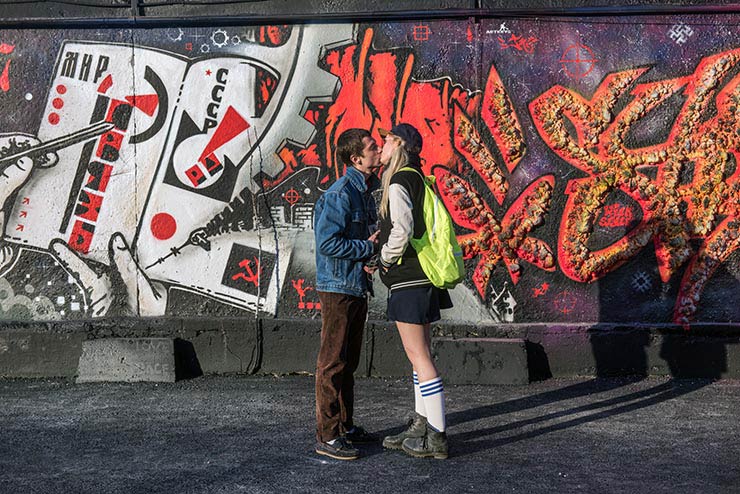
PDA at the Street Art Museum. Saint Petersburg, Russia. May 2017. (photo © Martha Cooper)
Please note: All content including images and text are © BrooklynStreetArt.com, unless otherwise noted. We like sharing BSA content for non-commercial purposes as long as you credit the photographer(s) and BSA, include a link to the original article URL and do not remove the photographer’s name from the .jpg file. Otherwise, please refrain from re-posting. Thanks!
 BROOKLYN STREET ART LOVES YOU MORE EVERY DAY
BROOKLYN STREET ART LOVES YOU MORE EVERY DAY
